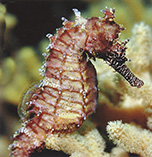| Family: |
Syngnathidae (Pipefishes and seahorses), subfamily: Syngnathinae |
| Max. size: |
15 cm OT (male/unsexed) |
| Environment: |
reef-associated; marine; depth range 0 - 12 m, non-migratory |
| Distribution: |
Western Central Pacific: Indonesia, Malaysia and the Philippines. |
| Diagnosis: |
Dorsal spines (total): 0-0; Dorsal soft rays (total): 16-22. Description: (based on 19 specimens). Adult height: 7.8-14.5 cm. Rings: 11 + 34-35 (33-36). Snout length: 2.2-2.3 (2.0-2.6) in head length. Dorsal fin rays: 19 (16-22) covering 2+1 rings. Pectoral fin rays: 17-18 (15-20). Coronet: medium-high; five sharp spines. Spines: well-developed, usually quite sharp eye spine; first dorsal trunk spine much longer than others and curved backwards; tail spines of different lengths (in regular series e.g. long, short, long, short). Other distinctive characters: double cheek spines, double spines below eye. Color pattern: white to pale yellow to pale brown; reddish brown spots and lines on body; snout often striped; fine lines radiating from eye. |
| Biology: |
Unlike most seahorses, this species is often found clinging to hard coral and doesn't seem to be worried about stingers (Ref. 48635). Ovoviviparous (Ref. 205). The male carries the eggs in a brood pouch which is found under the tail (Ref. 205). Popular spiny seahorse in aquarium trade; often sold bleached for traditional Chinese medicine. OT=height length. Minimum depth reported taken from Ref. 128812. |
| IUCN Red List Status: |
Vulnerable (VU); Date assessed: 19 January 2017 (A2cd) Ref. (130435)
|
| Threat to humans: |
harmless |
Source and more info: www.fishbase.org. For personal, classroom, and other internal use only. Not for publication.

